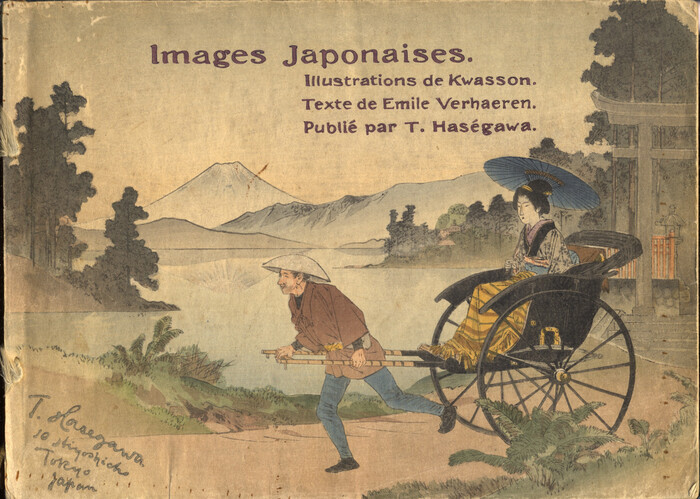Images japonaises
by Suzuki Kason
with poems by Émile Verhaeren
 |
| Front cover : Mount Fuji seen from Ashi lake and a lady in a rickshaw in front of the Torii of Hakone |
| Click on the image to access the book. A more detailed description of the woodprints (from the article by Ooba Tsuneaki2) is in the slideshow. |
Suzuki Kason 鈴木華邨, also known as Suzuki Sōtarō 鈴木 宗太郎, was a student of Kikuchi Yosai. He was also influenced by Ohara Koson and Ikeda Shoen. He is the author of numerous paintings, woodprints, Kuchi-e prints and chirimen-e such as the present one. He frequently uses a diagonal line to separate two parts of a print, a design called Kagami-gawari which is seen on kimonos, kosode, Noh costumes. In this book he draws the faces of women as if illustrating a Kuchi-e, and on some pages he uses artistic license to gather flowers and blossoms which may actually bloom in different seasons.
Hasegawa Takejirō was a Japanese publisher who specialized in books in European languages illustrated with woodprints by Japanese artists. He first published the book of woodprints by Suzuki in 1896 under the title of "The Smiling book" and with unidentified verses in English. The book was reedited after 1907 with the title "Glimpses of Japan" and poems in English by famous poets.
The British writer Osman Edwards, a friend of Verhaeren and an author of books for Hasegawa, is probably the one who, during his stay in Japan in 1898, suggested that Hasegawa ask Verhaeren to write poems to be included in a French version of "The Smiling book". Hasegawa obliged, and a first edition in French probably came out in 1898. Hasegawa also issued a special edition of the book on Hosho paper for The Exposition Universelle of 1900 in Paris1. Incidentally, at that Exposition Hasegawa was awarded a gold medal for "Scènes du théâtre japonais" and Kason was awarded a bronze medal for his woodprints. Verhaeren himself never travelled to Japan. His book nevertheless contributed to the the diffusion in Japan of his poetry, which was first translated by Ueda Bin in 1905.
Since the English and French editions of the book have the same woodprints, but different texts, they were not books of texts illustrated by woodprints, but rather the opposite ! Indeed, Verhaeren composed the first poem of the book after looking at the "20 cheerful sketches" of Kason. The English and French editions of the book also have same colophon, which gives a publication date of Meiji 29 (1896), even though both books had several editions between 1896 and 1911. The address of the publisher, which is given on the front cover, gives away the actual date of publication : it was "10 Hiyoshicho" until 1901, then "Yotsuya Hommura" until 1907 (some sources say 1911), and "17 Kami Negishi" thereafter. The front cover of our copy has the first address. There are other small differences between the various editions, such as the fonts of the text. The main difference is on page 20, for which we have found five different designs, which are shown here.
Many digitized copies of the book are available online : e.g. at Gallica, Tokyo Women's Christian University
Bibliography:
1.Jacques Marx, Du nouveau sur les images Japonaises de Verhaeren. Bulletin de l'Académie royale de langue et littérature françaises, Vol 77, pp.400-410, 1999 (available at https://www.arllfb.be/bulletin/bulletinsnumerises/bulletin_1999_lxxvii_03_04.pdf)
2. 大場恒明, エミール・ヴェルハーレンの Images Japonaises をめぐって, 国際経営論集, 16/17 85-106, 1999-03-25. (Ooba Tsuneaki, 1999, On Images Japonaises by Emile Verhaeren, International Business Review, 6/17 85-106, 1999-03-25) (https://kanagawa-u.repo.nii.ac.jp/records/1625)